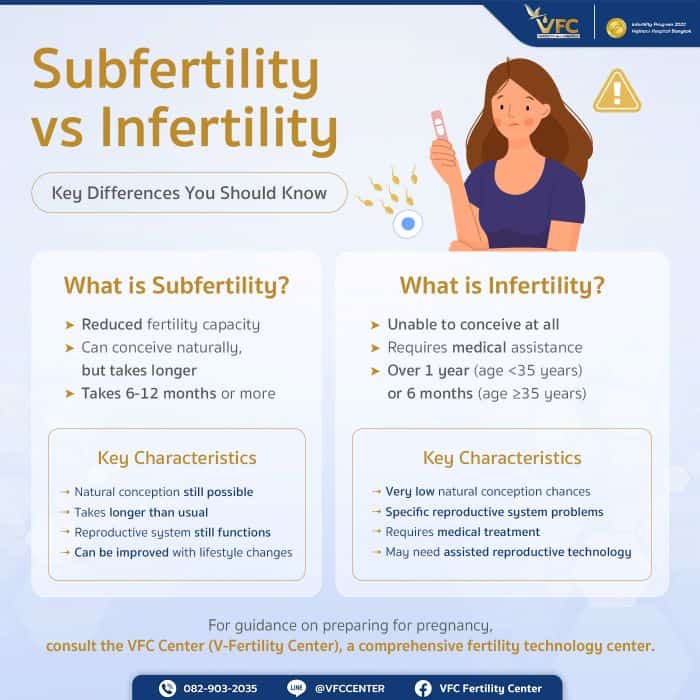
Understanding the difference between subfertility and infertility is essential for couples facing difficulty conceiving. Subfertility means conception is still possible naturally, just slower than expected—while infertility typically requires medical intervention. By identifying the causes of both conditions and seeking expert guidance, couples can make informed decisions, take timely action, and improve their chances of having a baby.
Many couples often confuse “subfertility” with “infertility“, when in fact these two conditions have distinct meanings. Understanding the causes of difficulty conceiving, including the differences between subfertility and infertility, will help you know the appropriate care methods and increase your chances of successful pregnancy.
1. What is Subfertility?
Subfertility refers to a condition where reproductive capacity is reduced from normal levels, but natural conception is still possible. However, it may just take longer than usual. This differs from infertility, where pregnancy may not be achievable without medical intervention.
This condition is commonly found among couples today, especially those who are older or have lifestyle changes from the past. However, understanding the characteristics and causes of this condition allows for effective behavioral modifications and improvements.
1.1 Key Characteristics of Subfertility
Understanding subfertility characteristics helps couples better understand their situation and plan appropriate care for the next steps.
- It takes 6-12 months or longer to conceive, but success is still possible. Couples with this condition typically require more time trying to conceive compared to normal couples, but it’s not impossible—it just requires patience and appropriate care.
- Hormones and the reproductive system still function, but with reduced efficiency. The reproductive system can still perform normally but may have delays or incomplete efficiency, such as irregular ovulation or slightly reduced egg and sperm quality.
- May have minor risk factors such as age, stress, or lifestyle. These factors often accumulate from daily life, such as working hard, insufficient sleep, or unbalanced nutrition, which may affect reproductive capacity.
Ready to consult with a fertility specialist? Get expert consultation here.
1.2 Common Causes of Subfertility
Understanding the causes of subfertility enables targeted improvements and corrections. Causes may come from the female partner, male partner, or both.
In Women
- Advanced age (after 35 years): As age increases, both the quantity and quality of eggs naturally decline. Additionally, hormones related to reproduction begin to change, reducing pregnancy chances and requiring more time, especially after age 35 when fertility capacity noticeably decreases.
- Minor ovulation irregularities: Irregular or delayed ovulation may result from stress, weight changes, or hormonal imbalances. These affect optimal ovulation timing and reduce fertilization chances.
- Mild hormonal imbalances: Such as abnormally elevated prolactin levels, minor thyroid dysfunction, or insulin resistance, all of which affect reproductive system function.
- Stress and an unbalanced lifestyle: Work stress, personal problems, or even pressure from trying to conceive can affect hormones and reproductive system function. Additionally, insufficient sleep or excessive or inadequate exercise can also contribute to subfertility.
In Men
- Reduced sperm quality: Incomplete sperm count, motility, and morphology due to various factors such as age, lifestyle, or environment. While still within normal ranges, efficiency may be reduced.
- Environmental factors such as heat and chemicals: Exposure to high temperatures like prolonged hot baths, tight clothing, working in hot environments, or exposure to various chemicals and toxins all affect sperm production and quality.
- Neglectful lifestyle habits: Smoking, alcohol consumption, eating unhealthy foods, lack of exercise, or being overweight all negatively impact reproductive system health.
2. What is Infertility?
Infertility is the inability to conceive within 1 year (for couples under 35) or within 6 months (for couples 35 and older) despite regular sexual intercourse without contraception.
Infertility is a medical condition requiring specific diagnosis and treatment, different from subfertility which may be improved through lifestyle changes. Understanding the characteristics and types of infertility helps ensure proper and effective treatment, as this condition often stems from anatomical problems or reproductive system dysfunction requiring medical treatment.
2.1 Types of Infertility
Categorizing infertility types helps doctors plan appropriate treatment and helps patients better understand causes and treatment approaches.
- Primary Infertility: This refers to couples who have never conceived before, despite trying for an extended period. Causes may include structural problems with reproductive organs present from birth, severe hormonal problems, or genetic issues. Treatment often requires detailed diagnosis and may need advanced reproductive technology.
- Secondary Infertility: This occurs in couples who have successfully conceived before but currently cannot conceive. Causes may result from changes occurring after previous pregnancies, such as infections affecting fallopian tubes, surgeries affecting reproductive organs, or age-related hormonal changes.
Consult with fertility specialists from VFC Center here.
2.2 Main Causes of Infertility
Understanding the causes of difficulty conceiving is crucial for determining appropriate treatment approaches. Causes may originate from the female partner, male partner, or both.
Women
- Blocked or abnormal fallopian tubes: Blocked tubes prevent sperm from reaching eggs or fertilized eggs from traveling to implant in the uterus. Causes often include past infections, abdominal surgeries, or endometriosis.
- Ovulation disorders: Such as ovarian failure, irregular ovulation, or no ovulation at all. May result from hormonal problems, ovarian inflammation, or genetic factors.
- Endometriosis: A condition where tissue similar to the uterine lining grows in other organs like ovaries or fallopian tubes, causing inflammation and scarring that affects reproductive system function.
- Uterine or ovarian abnormalities: Such as uterine fibroids, incomplete development of reproductive organs, or ovarian atrophy.
In Men
- Poor sperm quality, low count, or poor motility: This problem is commonly found in men with infertility. May result from genetic factors, infections, chemical exposure, or injury-related problems.
- Reproductive system abnormalities: Such as blocked sperm ducts, undescended testicles, or incomplete development of male reproductive organs.
- Hormonal problems: Abnormalities in hormones controlling sperm production, such as abnormal LH, FSH, or testosterone levels.
Combined Causes
Sometimes problems may come from both partners, such as overall reduced reproductive capacity in both partners, significantly decreasing pregnancy chances.
Unknown Causes
Approximately 10-15% of couples with fertility problems show no clear abnormalities despite comprehensive testing. In these cases, doctors often use empirical treatment methods or assisted reproductive technology.

3. Comparison Table: Key Differences Between Subfertility and Infertility
Comparing the key characteristics of both conditions provides clearer understanding of their differences and enables appropriate care planning for each couple’s situation.
| Characteristic | Subfertility | Infertility |
| Natural conception chances | Still possible to succeed | Very low or no chance |
| Time required | 6-12 months or more | Over 1 year (<35) or 6 months (≥35) |
| Reproductive system | Functions but with reduced efficiency | Has specific problems |
| Treatment | Lifestyle adjustments + monitoring | Has specific problems |
| Treatment success | High with natural methods | Requires assisted reproductive technology |
4. Diagnosis and Testing
Proper diagnosis is the foundation for effective treatment. Testing begins with basic assessments and gradually increases in detail as needed to obtain comprehensive information for treatment planning.
4.1 Initial Testing
Initial testing is important for assessing overall reproductive health and provides baseline information for future treatment planning.
For Women
- Menstrual history examination: Doctors will inquire about menstrual patterns, regularity, cycle length, symptoms, and contraceptive history to assess hormone function and ovulation.
- Physical and reproductive organ examination: General physical examination, internal examination, and breast examination to identify structural abnormalities, infections, or tumors that may affect fertility.
- Hormone testing (FSH, LH, AMH, Prolactin): Testing various hormone levels helps assess ovarian, pituitary, and prolactin function, all affecting reproduction. AMH testing also helps assess remaining egg reserves.
- Reproductive organ ultrasound: High-frequency sound wave examination helps visualize uterine and ovarian structure, follicle development, and identify any abnormalities.
For Men
- Semen analysis: The most important basic test evaluating sperm volume, concentration, motility, and morphology, as well as pH and presence of pathogens in semen.
- Male hormone testing: Testing testosterone, FSH, and LH levels helps assess hormonal system function controlling sperm production.
- Reproductive organ examination: Checking testicle size and shape, varicoceles, prostate gland, and sperm pathway assessment.
4.2 Advanced Testing
When initial testing cannot clearly identify causes or more detailed information is needed, these advanced tests are performed.
- HSG (Hysterosalpingography) – Fallopian tube testing: Injecting contrast material into the uterus and taking X-rays to view fallopian tube patency and uterine cavity shape. This method helps detect tube blockages or internal uterine structural abnormalities.
- Laparoscopy: Minimally invasive surgery inserting a small camera into the abdomen to directly view reproductive organs. Can detect and treat endometriosis, adhesions, or other problems simultaneously.
- Genetic testing: When genetic abnormalities are suspected, chromosome and fertility-related gene testing is performed, such as karyotype and Y chromosome microdeletion testing.
- Sperm-cervical mucus compatibility testing: Testing whether sperm can move through cervical mucus, which may have immune-related problems or abnormal mucus properties.
Schedule fertility testing and receive appropriate treatment at VFC Center

5. Treatment Methods
5.1 Treating Subfertility
Lifestyle Modifications
- Eating nutritious foods, increasing folic acid: Focus on leafy greens, fruits, quality proteins, and whole grains. Folic acid helps develop eggs and sperm while reducing genetic abnormality risks in babies.
- Regular but moderate exercise: Moderate exercise like walking, swimming, or yoga helps improve circulation, reduce stress, and maintain appropriate weight.
- Stress reduction through meditation and yoga: Stress affects reproductive hormones. Meditation practice, yoga, listening to music, or relaxing activities help increase pregnancy chances.
- Avoiding cigarettes, alcohol, and drugs: These substances negatively affect fertility. Quitting helps improve egg and sperm quality.
- Adequate sleep and rest: Sleeping 7-8 hours per night helps the body produce necessary hormones appropriately.
Ovulation Tracking
- Using ovulation test strips: LH test strips help predict ovulation timing. Sexual intercourse should occur on positive test days and 1-2 days after.
- Measuring morning body temperature: Temperature increases after ovulation and remains constant until the next menstrual period.
- Observing cervical mucus changes: Around ovulation, mucus becomes clear like raw egg white, stretchy, and slippery.
5.2 Treating Infertility
Infertility treatment requires medical expertise and advanced technology. Treatment methods depend on identified causes and problem severity.
Medication Treatment
- Ovulation stimulation drugs (Clomiphene, Letrozole): Used for women with irregular ovulation or no ovulation, requiring regular ultrasound and hormone monitoring.
- FSH, LH hormones: Used when the pituitary gland cannot produce sufficient hormones, requiring regular subcutaneous injections.
- Hormone balancing medications: Such as thyroid medication, Metformin, or Bromocriptine, depending on individual hormone problems.
Advanced Treatment
- Intrauterine insemination (IUI): Suitable for cases with slightly poor sperm quality or cervical mucus problems.
- In vitro fertilization (ICSI and IVF): Suitable for blocked fallopian tubes, severe endometriosis, or other complex problems.
Surgical Treatment
- Fallopian tube release surgery: For tubes blocked by adhesions.
- Endometriosis surgery: Helps reduce inflammation and improve the environment for conception.
- Reproductive organ abnormality correction: Such as removing uterine fibroids or treating male varicoceles.
Fertility assessment and proper treatment isn’t just about solving health problems—it’s an investment in your family’s happiness that you’ve dreamed of. Taking care of yourself today is the best gift you can give to your future baby and family. At VFC Center (V-Fertility Center), our medical team provides comprehensive care from fertility counseling and infertility screening in Thailand to accurate diagnostic testing and appropriate treatment planning for each couple.
Frequently Asked Questions (FAQs):
1. What is the difference between infertility and subfertility?
Subfertility means the ability to conceive is reduced but still possible with time, while infertility refers to the inability to conceive after 12 months (or 6 months if over age 35) of regular, unprotected sex. Infertility typically requires medical diagnosis and treatment.
2. What are the most common causes of difficulty conceiving?
Difficulty conceiving may be caused by female factors (such as blocked fallopian tubes, ovulation disorders, or endometriosis), male factors (like poor sperm quality or hormonal imbalances), or combined issues. Lifestyle, age, and unknown causes can also contribute.
3. How do doctors diagnose infertility or subfertility?
Doctors begin with a full medical history, physical exams, and basic tests such as semen analysis, hormone testing, and ultrasounds. Advanced diagnostics may include HSG, laparoscopy, or genetic testing depending on each couple’s needs.
4. Can lifestyle changes improve subfertility?
Yes. Eating nutritious foods, maintaining a healthy weight, reducing stress, and avoiding smoking or alcohol can improve egg and sperm quality. Tracking ovulation and getting enough rest can also help couples conceive naturally.
5. What fertility treatments are available for infertility?
Treatments range from medications that stimulate ovulation to assisted reproductive technologies like IUI, IVF, or ICSI. Surgery may also be needed in cases of blocked tubes, endometriosis, or reproductive organ abnormalities.
Article by Dr. Nannapat Parosiyanont
Contact or Book a Consultation:
VFC Center – V-Fertility Center
Hotline: 082-903-2035
LINE Official: @vfccenter

The team of specialists in obstetrics and gynecology and reproductive medicine





No Comments
Sorry, the comment form is closed at this time.